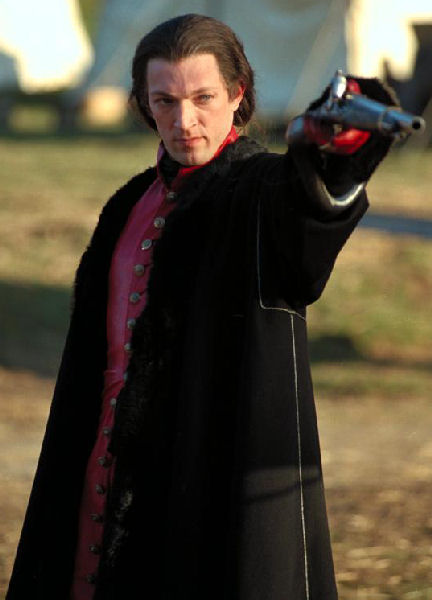
One of my YouTube subscriptions is Trey the Explainer, who does good stuff on history, natural history, evolution, and cryptid creatures, among other things. His latest Cryptid Profile is especially relevant to my interests, because it covers the ‘Beast of Gévaudan’, and I have by coincidence just finished helping with a forthcoming documentary about La Bête. I fully support his conclusion that this was a classic cryptid/social panic case, with anything and everything being identified/misidentified as the beast in question. It was very likely several wolves and/or wolf-dogs, possibly a hyena, possibly a lion or other escaped big cat, and possibly even all of the above. I won’t even rule out the suggestion of a human murderer or two in the mix somewhere. What it wasn’t was a single creature with a supernaturally hard or charmed hide. However, Trey gets a few facts wrong about werewolf and silver bullet mythology. Firstly, there’s no evidence that any of the creatures killed and recovered were actually dispatched with a silver bullet, and some good evidence that they weren’t (such as not being mentioned at all in period sources, notably an autopsy report). Suspected ‘Beasts’ WERE shot at with silver bullets but importantly, they apparently did not work. A Madame de Franquieres wrote to her daughter-in-law on the Beast:
‘The express sent to Aurillac relates that M. de Fontanges has had many encounters with the ferocious beast, of which you have no doubt heard, that traverses the Gevaudan. He has passed places where she often goes; he was forced to stay three days in the snow for fear of meeting her. She crosses, without wetting her feet, a river thirty-six feet wide. He claims that she can cover seven leagues in an hour. The peasants do not dare to go out into the country unless in groups of seven or eight. We can not find anyone to herd the sheep. She does not eat animals, only human flesh; men she eats the head and stomach, and women over the breasts. When she is hungry, she eats it all. We tried to shoot him with bullets of iron, lead, silver. Nothing can penetrate. We must hope that in the end we will overcome it.’
-M.”° de Franquières à M.”° de Bressac, Grenoble, 14 March 1765 – see the French original here (p.138).
This is supported by another source from 1862 (see here): that reports the use of ‘almost point blank’ folded silver coins, also to no apparent avail. Of course it’s possible that some poor wolf did slink away and die, but either wasn’t the Beast or wasn’t the only ‘Beast’ abroad at that time.
Trey is also under the impression that this incident is the source of the belief that silver bullets can kill werewolves. This is true insofar as there are no written accounts of silver bullet use against canids until Gévaudan, despite modern claims that the silver bullet aspect was only introduced in more modern times or even in fictionalised accounts. The source above proves otherwise. The story certainly helped to spread the idea and perpetuate it into the era of mass literacy and supernatural fiction. However, the idea that this is ground zero for silver bullets versus werewolves is untrue in the sense that the belief applied by no means just to werewolves, but rather to a range of supernatural or charmed targets (although as I’ve previously noted, not vampires until 1928). As such, it predates Gévaudan, meaning that there is in fact no source for the slaying of werewolves with silver bullets. For as long as silver bullets were ‘a thing’, they would have been seen as effective against werewolves or wolf-like supernatural beasts. I should note here that nowhere in the historical literature is the Beast of Gévaudan claimed to have been a loup-garou or werewolf. There are no accounts of it shifting shape, no accusations made of any people suspected to be the Beast. However, historians have noted in period reports werewolf traits such as a foul stench, unusually long claws and teeth, ‘haunting’, ‘sparkling’ or glowing eyes, and an erect posture (see Jay Smith’s ‘Monsters of the Gévaudan: The Making of a Beast’, p.21).
So where does the silver bullet myth come from? The oldest references that I’ve found are in Scots and American poems (1801 and 1806 respectively), and relate to yet another class of supernatural being, albeit one with close ties to the werewolf; that of the witch. The very earliest is the 1801 Scots poem ‘A Hunt’ by James Thomson:
‘Quoth he, “I doubt there’s something in’t, Ye’re no’ a hare.
Then in he pat a silver crucky [sixpence],
And says, “Have at ye now, auld lucky ;
Although ye were the de’il’s ain chucky,
Or yet himsell, If it but touch of you a nucky,
It will you fell.”’
The sacred cross on the face of the penny was significant. Other accounts mention that the projectile has actively been blessed. A Swedish story from the Gösta Berlings Saga mentions bullets cast from a church bell. But the silver itself seems to have had a divine and magical significance, one that stretches back to ancient times (notably the Delphic Oracle, see this fantastic collection of references). In the German folk tale ‘The Two Brothers’ for example, the witch is shot at with three ordinary silver buttons.
My next source, ‘The Country Lovers‘ (published by Thomas Green Fessenden in 1804) comes from the United States:
‘And how a witch, in shape of owl,
Did steal her neighbour’s geese, sir,
And turkies too, and other fowl,
When people did not please her.
Yankee doodle, &c.
And how a man, one dismal night,
Shot her, with silver bullet,*
And then she flew straight out of sight,
As fast as she could pull it.
Yankee doodle, &c.
How Widow Wunks was sick next day,
The parson went to view her, And saw the very place, they say,
Where foresaid ball went through her !
Yankee doodle, Sec.
*There is a tale among the ghost-hunters, in New England, that silver bullets will be fatal to witches, when those of lead would not avail.
More Germanic folklore, recorded in 1852 (Benjamin Thorpe’s Northern Folklore, Vol.III, p.27), related that a witch, if shot with silver, would receive a wound that would not heal, and would have to resume its human form. Witches were commonly thought to shapeshift into animal form, hence the overlap with the werewolf. The ‘Witch of Schleswig’ was also known as ‘The Werewolf of Husby’,
Beyond witches, silver bullets might help against other entities. One story includes a shot used against the magic itself rather than the offending creature’s body; in this case a group of fairies;
‘In a Norse tale, a man whose bride is about to be carried off by Huldre-folk, rescues her by shooting over her head a pistol loaded with a silver bullet. This has the effect of dissolving the witchery; and he is forthwith enabled to seize her and gallop off, not unpursued.’
Frank C. Brown recorded (from North Carolina) a variety of uses of silver (bullet and otherwise) against black magic of all sorts. Ghosts are also associated with silver bullets, as in Washington Irving’s ‘Tales of a Traveller’, Vol.2 (1825), which references a (fictional) pirate ghost. Collections/indices of American folklore also reference ghosts as well as witches (e.g. ‘Kentucky Superstitions’ (1920).
However, the very oldest written accounts were made in reference to ordinary human beings that have been protected (or have protected themselves) by magical charms. These were known as ‘hardmen’, and were typically powerful or noteworthy men with a literal aura about them. One such was John Graham of Claverhouse, Viscount Dundee, who led the Jacobites at the Battle of Killiecrankie in 1689. As Sir Walter Scott wrote in ‘Tales of My Landlord’ (1816, p.69):
‘Many a whig that day loaded his musket with a dollar cut into slugs, in order that a silver bullet (such was their belief) might bring down the persecutor of the holy kirk, on whom lead had no power.’
The same went for 17th/18th century Bulgarian rebel leader ‘Delyo’, and ‘…an Austrian governor of Greifswald, on whom the Swedes had fired more than twenty balls, could only be shot by the inherited silver button that a soldier carried in his pocket’ (see here). The oldest of all pertains to an alleged 1678 attempt upon the life of English King Charles II.
My point is really that the whole silver bullet myth is misunderstood today. It’s not like the wooden stake that’s specific to vampires or, for that matter, wolfsbane for wolves, conkers for spiders (yes, that’s a genuine belief too). The silver bullet is not specific to werewolves, vampires, or any other target. It is really an apotropaic – it works against magic itself, whether negating the charm of protection around a corporeal enemy, dispelling a ghostly apparition, or breaking fairy magic to free a captive. It’s the ultimate in supernatural self-defence, but it’s only a footnote in the story of the Beast of Gévaudan. It neither originated with the Beast, nor killed it.



